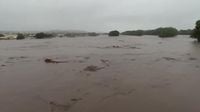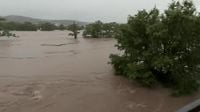Kerrville, Texas, and the surrounding Hill Country faced a devastating natural disaster on July 4, 2025, as catastrophic flooding along the Guadalupe River swept through the area, leaving at least 13 people dead and dozens missing, including many children from local summer camps. The normally festive Fourth of July celebrations turned into frantic rescue and recovery efforts as emergency services scrambled to respond to one of the worst floods in the region’s history.
Heavy rainfall overnight on July 3 and into the early hours of July 4 triggered the flooding. More than 8 inches of rain fell in just a few hours, with some reports indicating over a foot of rainfall in the Hill Country. The Guadalupe River’s water level rose at a terrifying pace, reaching nearly 30 feet in some locations. At Comfort, the river surged 22 feet in just 30 minutes between 9:00 a.m. and 9:30 a.m., while in Kerrville, it climbed 21.6 feet in one hour early that morning. The river at Hunt rose from 7 feet at midnight to more than 29 feet by 4 a.m., one of the highest crests on record, surpassing the historic 1987 flood. The National Weather Service described the situation as "life-threatening," and a Flash Flood Emergency was declared early Friday morning.
The suddenness and severity of the flooding caught many residents off guard. City Manager Dalton Rice described the rapid rise of the river: "I was running the river trail at 3 a.m. this morning. There was no sign of it rising at that point. This happened very quickly at a short amount of time that could not be predicted... this is not like a tornado where you can have a siren. It hit and it hit hard." Homes near the river were inundated, with some swept off their foundations and others surrounded by mud and debris. Vehicles were submerged, displaced, or destroyed. Streets throughout Kerrville and nearby towns were flooded, littered with debris, and many roads were closed, including Arcadia Loop, Thompson Drive, Guadalupe Street, and Riverside Drive.
The human toll quickly became apparent. The Kerr County Sheriff’s Office called the flooding "catastrophic," confirming at least 13 deaths with more expected as search efforts continued. Several people remain missing, including at least 20 girls from Camp Mystic, a girls-only summer camp located along the Guadalupe River near Hunt. Lt. Governor Dan Patrick, who was acting as Texas governor during the emergency, reported that the missing campers might be trapped or out of communication, and parents had been notified about unaccounted children. Camp Mystic and other camps along the river struggled to coordinate rescue efforts, especially as nearby highways were washed away, complicating access.
Kerr County Judge Rob Kelly, who confirmed the fatalities, emphasized the unprecedented nature of the event, stating the flooding "far surpasses" the 1987 flood, which had already been devastating. He noted that the exact number of missing campers was still unknown as of mid-morning on July 4, with officials doing their best to account for everyone.
In response to the disaster, Kerrville Mayor Joe Herring Jr. issued a disaster declaration, activating the city’s emergency management plan. Emergency shelters were established at First United Methodist Church, Calvary Temple Church, Notre Dame Catholic Church, Schreiner University Event Center, and the Arcadia Live Theater. Reunification centers for displaced families were set up at Ingram Elementary School and the Walmart at Junction Highway. The Red Cross assisted with reunification efforts, providing a hotline for those seeking missing loved ones.
Emergency crews were active throughout Kerr County and neighboring areas, conducting high-water rescues and evacuations. Helicopters and rescue teams with swimmers were deployed, with reports of people trapped on rooftops in Hunt. The Kerrville Fire Department monitored nursing and assisted living homes sheltering in place, prepared to evacuate residents if necessary. Officials urged residents to shelter in place, avoid travel, and immediately move to higher ground if near creeks, streams, or the Guadalupe River.
Power outages compounded the crisis. The Kerrville Public Utility Board reported widespread outages in southeast Kerrville, Center Point, and Hunt. Flooding had rendered some substations inaccessible, and power lines crossing rivers were down. Restoration efforts were underway but hampered by hazardous road conditions.
State leadership responded swiftly. Governor Greg Abbott stated that Texas was providing all necessary resources, including water rescue teams, sheltering centers, the National Guard, and the Department of Public Safety. Acting Governor Dan Patrick coordinated with emergency teams and warned that additional rain could worsen flooding over the coming days. He urged Texans to heed local officials’ guidance and avoid flooded areas. President Donald Trump pledged federal assistance to support the state's response.
Beyond Kerrville, flooding affected other parts of the Texas Hill Country and Central Texas. Bandera County experienced high water levels on multiple highways and creeks, and the San Saba and Llano Rivers were at or near record flood stages. The National Weather Service warned of ongoing flash flooding threats from San Antonio to Waco for 24 to 48 hours.
The tragedy highlighted the dangers of flash floods, which can develop rapidly and unpredictably. Experts note that warmer air holds more moisture, intensifying rainfall events and increasing flood risks. Flash floods claim an average of 88 lives annually in the United States, often because people underestimate the speed and force of rising waters or attempt to drive through flooded roads.
Officials and emergency responders emphasized the importance of preparation and caution. Recommendations include having a family emergency plan, preparing a “go bag” with essentials, staying alert to weather alerts, and never driving through floodwaters. Rescue experts advised that if trapped in a vehicle by floodwaters, occupants should roll down windows, unbuckle seatbelts, and seek higher ground on the roof, rather than attempting to abandon the vehicle prematurely.
The Hill Country flooding of July 4, 2025, serves as a grim reminder of nature’s power and the necessity of vigilance during severe weather. As recovery efforts continue, communities band together to support those affected, hoping to heal from a disaster that transformed a day of celebration into one of mourning and resilience.





